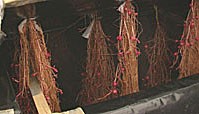Lima, Peru
February 2, 2007
 The
roots and the tubers grow suspended in the air, without touching
the soil. Growing potatoes in mid-air, in a new technique called
aeroponics, is showing great promise. The technique consists of
cultivating potato seedlings on specially adapted frames so that
the roots, and the tubers, grow suspended in the air, without
touching the soil. The
roots and the tubers grow suspended in the air, without touching
the soil. Growing potatoes in mid-air, in a new technique called
aeroponics, is showing great promise. The technique consists of
cultivating potato seedlings on specially adapted frames so that
the roots, and the tubers, grow suspended in the air, without
touching the soil.
This avoids the need to disinfect the soil with harmful
chemicals and keeps the tubers healthy as well. The frames are
covered with black plastic to keep out the light and the plants
are sprayed with a solution of nutrients to allow them to grow.
The International Potato
Center (CIP) is using the technique to improve production
and reduce the cost of producing seed potatoes. The method is up
to ten times more effective than with the conventional
techniques. Another advantage is that the little tubers can be
harvested at any size seed user wants, from 5 to 30 grams.
Spraying fertilizers directly on to the roots makes it possible
for the growth phase to continue for more than 180 days without
interruption, which does not happen with conventional
techniques.
First results have been very successful. For example, 67 seed
tubers were obtained per plant with the variety Yungay; with
Canchán INIA, 70 tubers and with Perricholi, 69. With
conventional techniques, the average is from 5 to 10 tubers per
plant.
Seed potatoes are very important for potato producers because
the success of the harvest will depend on the quality of seed
tubers used. Virologists from CIP’s Integrated Crop Management
division are working with the Experimental Station of Santa Ana
in Huancayo, where the Germplasm Acquisition and Distribution
Unit is producing optimal seed tubers of first class sanitary
quality for researchers who require them.
Growing potatoes in mid-air, with a technique called
aeroponics, is showing great promise for the
production of seed potatoes. Seed potatoes are very
important for potato producers because the success
of the subsequent harvest depends on the quality of
the seed tubers used.
The technique consists of cultivating potato
seedlings on specially adapted frames so that the
roots, and the tubers, grow suspended in the air,
without touching the soil. This avoids the need to
disinfect the soil with harmful chemicals and also
keeps the tubers healthy. Plantlets with roots are
pushed through the top of a table-like structure.
The frames are covered with black plastic to keep
out the light and the roots are sprayed with a
recirculated solution of nutrients to allow them to
grow.
“In the greenhouse, seed potatoes were traditionally
grown in soil that had been sterilized with methyl
bromide, because it was cheap, effective in killing
pathogens and weed seeds but it did not alter the
characteristics of the substrate,” said Victor
Otazú, the chief of CIP’s experimental station of
Santa Ana in Huancayo. However, bromine is 60 times
more destructive to the ozone layer than chlorine,
so methyl bromide was put on the the list of banned
ozone-depleting substances of theUnited Nations
Montreal Protocol.
Sterilizing the soil with heat is also expensive, so
CIP is using looking at aeroponics to improve
production and reduce costs. The method is up to ten
times more effective than conventional techniques.
“First results have been very successful,” said
Victor Otazú. For example, 67 seed tubers were
obtained per plant with the variety Yungay; with
Canchán INIA, 70 tubers and with Perricholi, 69.
With conventional techniques in pots, we get 5 to 10
tubers per plant.”
Another advantage is that the little tubers can be
harvested at any size the seed user wants, from 5 to
30 grams. The process also allows stepped harvests.
Spraying fertilizers directly on to the roots makes
it possible for the growth phase to continue for
more than 180 days without interruption, which does
not happen with conventional techniques. There is a
small investment in equipment needed, but still the
tubers work out significantly cheaper.
“The technology is novel in the sense that very few
people are aware of it or its potential,” said CIP
virologist and seed system specialist Ian Barker,
“but it has been used in China and Korea for some
time.” Even NASA's long range plans for a visit to
Mars reveal that the surface crew will spend 60% of
their time farming to sustain themselves. Aeroponics
is considered the agricultural system of choice
because of its low water and power inputs and high
volume of food output per sq meter.
CIP’s Germplasm Acquisition and Distribution Unit is
already using the technique to produce optimal seed
tubers of first class sanitary quality for
researchers. Further work in Huancayo will look at
the suitability of the technique for a wide range of
genotypes including native varieties.
There has also been a lot of demand already for
information and training. The Peruvian national
research program INIEA is interested and researchers
in Ecuador want to install a unit in that country.
CIP’s Paul Demo sees much promise for southern
Africa. |
|